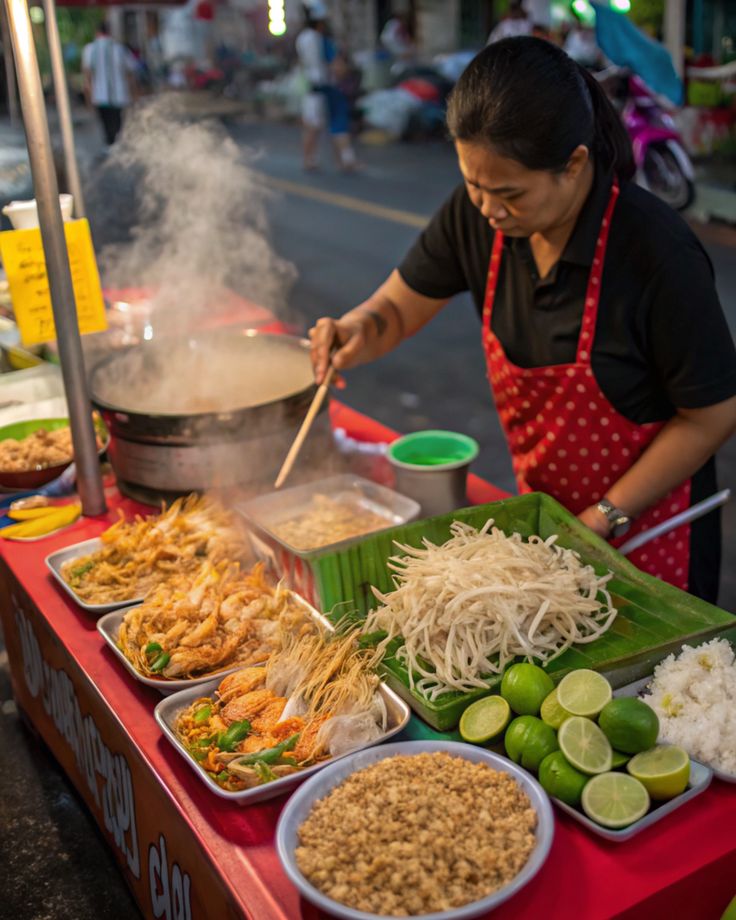What To Eat in Thailand. Best Popular Food Guide

We’re diving headfirst into the glorious, mouth-watering abyss of Thai cuisine. Forget your local takeout place, because I’m about to spill the tea (or should I say, the tom yum goong!) on the 20 best dishes to try when you hit up the Land of Smiles. As someone who’s practically had my passport stamped in every street food stall from Chiang Mai to Southern Thailand, trust me, I’ve got the inside scoop on how to get those taste buds doing a happy dance. Get ready, because this is going to be an authentic, upbeat, and utterly delicious ride!
The magic of Thai food culture lies in its perfect balance. It’s not just about heat; it’s about a symphony of sweet, sour, salty, and spicy, often with a hint of bitter to keep things interesting. The main ingredients are always fresh – think vibrant fresh herbs like Thai basil, lemongrass, galangal, and those fragrant kaffir lime leaves. And of course, the ever-present fish sauce and bright lime juice are the backbone of so many incredible flavors. Forget bland, embrace bold!
Let’s kick things off with the heavy hitters, the most popular Thai dishes that have earned their legendary status:
The Culinary A-Listers: Don’t You Dare Miss These!

Pad Thai:

Okay, I know, I know. It’s the one everyone talks about, but there’s a reason this national dish is so beloved! A true Pad Thai from a bustling street vendor is a revelation. I’m talking perfectly stir-fried rice noodles with plump shrimp or tender chicken, crunchy bean sprouts, chives, and a scrambled egg, all coated in a tangy, sweet, and savory tamarind-based sauce. A squeeze of fresh lime juice and a sprinkle of crushed peanuts? Absolute perfection. It’s the ultimate introduction to Thai cuisine, a harmonious blend that sets the stage for everything else.
Tom Yum Goong (Spicy Shrimp Soup):

If Pad Thai is the welcoming hug, Tom Yum Goong is the fiery kiss! This intensely aromatic and spicy sour soup with succulent shrimp is an absolute masterpiece. Imagine a steaming bowl of broth infused with lemongrass, galangal, kaffir lime leaves, and a generous amount of red chili peppers. The vibrant spices, the tang of lime, and the umami of fish sauce create a truly invigorating experience. Seriously, one spoonful and you’ll feel alive! It’s undoubtedly one of the best Thai dishes, especially if you love spicy food.
Som Tam (Spicy Green Papaya Salad):

Get ready for a textural and flavor explosion! This spicy green papaya salad is a crunchy, zesty, and often fiery delight. Shredded unripe papaya, green beans, tomatoes, peanuts, and sometimes dried shrimp are pounded with garlic, fresh chilli peppers, fish sauce, lime juice, and a touch of palm sugar in a mortar and pestle. It’s fresh, vibrant, and incredibly addictive, especially on a hot day. I’ve seen Thai people eat this at every meal, and once you try it, you’ll understand why.
Green Curry (Gaeng Keow Wan Gai):

Ah, the iconic Green Curry! This vibrant, creamy, and undeniably spicy curry is a staple for a reason. Made with a rich coconut milk base and a paste of fresh green chilies, lemongrass, galangal, and shrimp paste, it’s typically served with tender chicken (gai), bamboo shoots, and Thai eggplant. It’s a comforting yet exhilarating main course that perfectly showcases the complexity of Thai curries. Pair it with a bowl of fragrant jasmine rice to soak up every last drop of that glorious sauce.
Khao Soi:

If you find yourself in Northern Thailand, particularly Chiang Mai, drop everything and find some Khao Soi! This is hands down one of my personal favorite noodle soup dishes. It’s a rich, creamy, and slightly spicy coconut curry noodle soup, usually with tender chicken or beef, served over soft egg noodles, and topped with a nest of crispy fried egg noodles. The contrast in textures and the depth of flavor are simply incredible. It’s a dish unique to Northern Thailand and a truly unforgettable Thai meal.
Beyond the Classics: Deepening Your Dive into Thai Flavors

Tom Kha Gai (Chicken Coconut Soup):

For those who love the aromatics of Tom Yum but prefer a milder heat, Tom Kha Gai is your go-to. This luscious soup features tender chicken and mushrooms simmered in a creamy coconut milk base infused with galangal, lemongrass, and kaffir lime leaves. It’s still got that tangy kick from lime juice but is much more mellow and soothing than its spicier cousin. Perfect for a comforting Thai meal.
Massaman Curry (Gaeng Massaman):

Prepare for a flavor journey! This richly aromatic curry has distinct influences from Chinese immigrants and Indian cuisine, often featuring slow-cooked beef or chicken, potatoes, and peanuts in a thick, slightly sweet coconut milk base. The curry paste includes warm spices like cardamom, cinnamon, and star anise, giving it a unique depth that sets it apart from other Thai curries. It’s a hearty and incredibly satisfying best Thai food experience.
Pad See Ew:

Another fantastic stir-fried noodles dish that often gets overshadowed by Pad Thai. Pad See Ewfeatures wide, flat rice noodles (sen yai) stir-fried with Chinese broccoli, egg, and your choice of protein in a savory dark soy sauce and oyster sauce. It has a beautiful smoky flavor from the high heat of the wok, often referred to as “wok hei.” It’s comfort food supreme, less tangy than Pad Thai but equally addictive.
Khao Pad (Thai Fried Rice):

Don’t underestimate a good Khao Pad! While it might seem simple, a well-executed Thai fried rice is a culinary delight. Fragrant jasmine rice is stir-fried with egg, your choice of protein (chicken, pork, shrimp), and a delicate balance of fish sauce, soy sauce, and a touch of sugar. Often topped with a perfectly fried egg and served with a wedge of lime and sliced cucumber, it’s a quick, easy, and incredibly satisfying Thai meal.
Red Curry (Gaeng Phet):

This fiery and fragrant red curry is another essential in the repertoire of Thai curries. Made with a vibrant red curry paste (from dried red chili peppers), it’s often cooked with duck, pork, or chicken, bamboo shoots, and sometimes pea eggplant. It’s spicier than the Massaman but still boasts that creamy richness from coconut milk base. For an extra layer of flavor, some versions might include fragrant Thai basil leaves.
Savory Sensations: More Must-Try Delicacies

Pla Pao (Salt-Crusted Grilled Fish):

Oh, this one is a showstopper! Whole fish (often Tilapia or Red Snapper) is generously stuffed with lemongrass, kaffir lime leaves, and Thai basil, then coated in a thick crust of salt before being grilled over charcoal. The result is incredibly moist, flaky fish with a beautifully infused aroma. Served with a variety of spicy dipping saucees, it’s a healthy and delicious way to enjoy fresh seafood, especially prevalent in Southern Thailand.
Moo Ping (Grilled Pork Skewers):

You’ll see these everywhere at street food stalls, and for good reason! Tender, marinated pork skewers are grilled over charcoal until beautifully caramelized. The marinade often includes garlic, pepper, and palm sugar, giving them a sweet and savory glaze. They are the perfect snack or a fantastic accompaniment to sticky rice. Seriously, I could eat these all day.
Pad Kra Pao (Stir-Fried Basil):

This is a lightning-fast, incredibly flavorful stir-fry that’s a favorite among Thai people. Minced pork, chicken, or beef is quickly stir-fried with a generous amount of holy Thai basil, garlic, and fiery chilli peppers, along with a splash of fish sauce and oyster sauce. Served over jasmine rice and often topped with a crispy fried egg (kai dao), it’s a fragrant, spicy, and utterly satisfying dish. Ask for it “khai dao” if you want that egg!
Kai Jeow (Thai Omelette):

Don’t let the simplicity fool you; a Thai omelette is a thing of beauty. Unlike a fluffy French omelette, Kai Jeow is typically crispy on the outside and wonderfully savory. Eggs are whisked with a touch of fish sauce, sometimes minced pork, and then fried in hot oil until golden and puffed up. It’s often served over white rice with a dollop of sweet chili sauce, making for a comforting and quick Thai meal.
Panang Curry:

Similar to red curry but often thicker, sweeter, and with a pronounced peanut flavor. Panang Curry typically uses pork or chicken and is less spicy than green or red curry, making it a great option if you’re easing into Thai heat. The addition of ground peanuts in the paste gives it a distinctive richness and a beautiful aroma, often garnished with finely sliced kaffir lime leaves. Another fantastic entry in the world of Thai curries.
Sweet Endings and Unique Bites: Rounding Out Your Thai Feast

Kao Niew Ma Muang (Mango Sticky Rice):

This is more than just a dessert; it’s a cult phenomenon! If you’re in Thailand during mango season (typically April to June), you must indulge in Kao Niew Ma Muang. Sweet, perfectly ripe mango slices are served alongside warm, sweet glutinous rice (sticky rice) that’s been infused with rich coconut cream and a sprinkle of toasted mung beans or sesame seeds. It’s pure, unadulterated bliss – a harmonious blend of sweet, creamy, and subtly salty.
Pad See Ew (Wider Noodle Version):

Yes, it’s on the list twice, because it’s that good and has variations! While sometimes referred to as just “Pad See Ew,” there’s also a version with even wider stir-fried noodles (often called “sen yai” specifically) that has a slightly different texture and mouthfeel, emphasizing the chewy noodles and the wok-kissed flavors even more. A definite contender for best Thai food in the noodle department.
Poh Pia Tod (Fried Spring Rolls):

These crispy spring rolls are the ultimate snack or appetizer. Filled with glass noodles, shredded cabbage, carrots, and sometimes minced pork, they are fried to golden perfection and served with a tangy sweet chili sauce. While inspired by Chinese cuisine (often called “Chinese spring rolls”), the Thai version has its own distinct flavor profile. You’ll find them at nearly every street food stall and they are always a crowd-pleaser.
Morning Glory (Pad Pak Boong):

Don’t knock it till you try it! This simple yet incredibly flavorful stir-fried vegetable dish is a staple. Morning Glory (water spinach) is quickly stir-fried with garlic, chilli peppers, and a savory sauce often incorporating oyster sauce, fish sauce, and fermented soybean paste. It’s a delicious and healthy way to get your greens, and it makes a fantastic side dish for any Thai meal.
Sai Oua (Northern Thai Sausage):

For a truly authentic taste of Northern Thailand, seek out Sai Oua. This flavorful grilled pork sausage is packed with fresh herbs like lemongrass, galangal, kaffir lime leaves, and a good kick of chili. It’s incredibly aromatic and has a wonderfully complex flavor profile. Often served with sticky riceand fresh vegetables, it’s a must-try for anyone exploring the culinary delights of Chiang Mai and beyond.
Embracing the Street Food Scene & Navigating Your Plate

The best way to truly experience Thai cuisine is to dive into the street food stalls. Don’t be shy! Wander through the local markets – the sights, sounds, and smells are an adventure in themselves. Most street vendors specialize in just a few dishes, ensuring they are masters of their craft. Don’t be afraid to point to what looks good, or use a few basic Thai phrases like “mai pet” (not spicy) or “pet nit noy” (a little spicy) if you’re wary of the heat.
For my vegetarian options fam, Thailand is surprisingly accommodating! Many dishes can be made with tofu or just vegetables. Just be sure to specify “gin jay” (vegetarian) or “mai sai neua sat” (no meat) and clearly communicate your dietary needs. Curries like Yellow Curry and even some versions of Green or Red Curry can often be made vegetarian by omitting shrimp paste (which is a common main ingredient in curry pastes, so always double-check!). Noodles dishes like Pad Thai and Pad See Ew are also easily customizable with tofu or just vegetables.
The influence of Chinese immigrants on Thai cuisine is evident in many dishes, from the use of stir-frying techniques to ingredients like dark soy sauce and egg noodles. This fusion has created an incredibly rich and diverse culinary landscape.
Have your tried Pad Thai , the most well know Thai dish ?

What Exactly Is Pad Thai?

At its heart, Pad Thai (which literally translates to “fried Thai-style”) is a vibrant, incredibly addictive stir-fried rice noodles dish. It’s a harmonious blend of sweet, sour, salty, and umami flavors, often with a delightful hint of spice.Imagine thin, flat rice noodles tossed in a super-hot wok with a magical sauce, then combined with protein (most commonly shrimp, chicken, or tofu), crunchy bean sprouts, chives, and usually a scrambled egg. It’s typically served with fresh garnishes like crushed peanuts, a wedge of lime juice, and sometimes extra chili flakes or palm sugar on the side, so you can customize it to your heart’s content.
It’s the ultimate example of perfect balance in a single bowl, a reflection of Thailand’s culinary philosophy. It’s simple yet complex, humble yet iconic.
The Fascinating History of Pad Thai

Here’s the kicker: for a dish that feels so ancient and deeply rooted in Thai food culture, Pad Thai is actually a relatively modern invention!
Its origins are often traced back to the 1930s and 1940s, specifically during the era of Prime Minister Plaek Phibunsongkhram (known as Phibun). During World War II, Thailand faced an economic crisis and a rice shortage.Phibun, a fervent nationalist, sought to promote national unity and reduce rice consumption by encouraging the consumption of noodles, which used less rice. He also wanted to create a distinctive national dish that would put Thailand on the culinary map and help forge a stronger national identity, especially as the country was trying to distance itself from its Chinese influences.
So, the government actually promoted the recipe for this stir-fried noodle dish, encouraging street vendors to sell it. They even provided recipes and carts to help people start their own stalls! While stir-fried noodles already existed in Thailand (brought over by Chinese immigrants centuries ago, with influences from Chinese cuisine), Phibun’s government formalized and popularized what we now know as Pad Thai, emphasizing its unique Thai flavors (especially the sweet and sour elements from tamarind and lime, distinguishing it from purely Chinese stir-fries).
It was a brilliant piece of culinary propaganda that worked! Pad Thai quickly became a staple, beloved by Thai peopleacross the country, and eventually, a global sensation. It’s a dish born out of necessity, transformed into a symbol of national pride, and now, a beloved icon of Southeast Asian cuisine.
How Is It Made? (The Anatomy of a Perfect Plate)

The secret to a truly great Pad Thai lies in its fresh ingredients, high heat, and that unforgettable sauce.
The Main Components:
- Noodles: Typically thin to medium flat rice noodles (often called “rice stick” noodles). They’re usually soaked, not boiled, to achieve the right pliable texture before stir-frying.
- Protein: Most commonly shrimp (goong), chicken (gai), or firm tofu. Sometimes a combination, or even just vegetarian.
- Aromatics: Fresh garlic and shallots form the flavorful base.
- Eggs: Scrambled into the noodles, adding richness and texture.
- Crunch & Freshness: Bean sprouts and Chinese chives (or green onions) are stirred in at the very end to retain their crispness.
- The Pad Thai Sauce: This is the soul of the dish! It’s a magical concoction that typically includes:
⦁ Tamarind paste/puree: Provides the essential sour tang.
⦁ Palm sugar: For sweetness, balancing the sour and salty.
⦁ Fish sauce: The backbone of savory, umami flavor. Sometimes a touch of dark soy sauce or oyster sauce for depth. Sometimes a touch of dark soy sauce or oyster sauce for depth.
- Garnishes: Crushed roasted peanuts (for texture and nutty flavor), fresh lime wedges (for a crucial final squeeze of acidity), and often dried chili flakes or fresh chilli peppers for adjustable heat. Some authentic versions also include dried small shrimp and sweet preserved radish (chai po) for an extra layer of umami and texture.
The Cooking Method (The Wok Wizardry):

- Pad Thai is a fast-paced dish, typically cooked in a super-hot wok or large skillet. Speed is key to prevent the noodles from becoming mushy and to get that characteristic “wok hei” (smoky breath of the wok).
- Prep Everything! This is crucial. Get all your ingredients chopped, measured, and ready to go. The cooking happens quickly, so you won’t have time to chop garlic once the wok is hot!
- Soak the Noodles: Place your dried rice noodles in a bowl and cover them with room temperature or slightly warm water (not boiling!). Let them soak for 30-60 minutes, or until they are pliable but still firm. They will finish cooking in the wok.
- Make the Sauce: In a separate bowl or small saucepan, whisk together the tamarind paste, palm sugar, fish sauce, and a bit of water until the sugar dissolves. Some recipes involve melting the palm sugar into a caramel first for a deeper flavor.
- Heat the Wok: Get your wok (or a large non-stick skillet) screaming hot over high heat. Add a neutral oil.
- Cook Protein & Aromatics: Stir-fry your chosen protein (chicken or shrimp) until it’s almost cooked through, then remove it. Add more oil if needed, then quickly stir-fry the chopped garlic and shallots (and dried shrimp/preserved radish if using) until fragrant.
- Add Noodles & Sauce: Add the soaked, drained noodles to the wok. Pour in the Pad Thai sauce. Stir-fry constantly, tossing the noodles to ensure they are evenly coated and absorb the sauce. This is where they’ll soften completely. If they seem too dry or sticky, a tiny splash of water can help.
- Scramble the Egg: Push the noodles to one side of the wok, add a little more oil to the empty space, and crack in the eggs. Scramble them quickly until about 90% cooked, then mix them into the noodles, breaking them up.
- Final Veggies & Toss: Turn off the heat. Add the bean sprouts and Chinese chives (or green onions). Toss everything together with the residual heat. You want the bean sprouts to be just slightly wilted, still retaining a crunch.
- Serve and Garnish: Plate your Pad Thai immediately. Garnish generously with crushed peanuts and a fresh lime wedge. Some people like to add a pinch of sugar or chili flakes on the side for extra customization.
How to Cook It (A Simplified Home Version)

Want to try making this best Thai food at home? Here’s a user-friendly recipe that captures the authentic flavors without needing a professional wok burner!
Yields: 2 servings Prep time: 20 minutes (plus noodle soaking) Cook time: 10-15 minutes
Ingredients:
For the Pad Thai Sauce:
⦁ 3 Tbsp tamarind paste (Thai brand, not dark Indian concentrate)
⦁ 3 Tbsp fish sauce
⦁ 2-3 Tbsp palm sugar, finely chopped (or brown sugar)
⦁ 2 Tbsp water
⦁ (Optional: 1 tsp oyster sauce for extra savory depth)
For the Pad Thai:
⦁ 4 oz (approx. 115g) dried flat rice noodles (medium thickness, ~5mm wide)
⦁ 2 Tbsp neutral cooking oil (like vegetable or canola)
⦁ 100g (approx. 3.5 oz) protein: thinly sliced chicken breast, medium shrimp (peeled & deveined), or firm tofu (cubed)
⦁ 1 small shallot, finely chopped
⦁ 2 cloves garlic, minced
⦁ (Optional: 1 Tbsp dried small shrimp, rehydrated)
⦁ 2 large eggs, lightly beaten
⦁ 1 cup bean sprouts (plus more for serving)
⦁ 1/4 cup Chinese chives (or green onions), cut into 1-inch pieces
⦁ 1/4 cup roasted peanuts, coarsely crushed (plus more for serving)
⦁ 1 lime, cut into wedges (for serving)
⦁ (Optional: chili flakes or sweet chili sauce for serving)
Instructions:
⦁ Soak Noodles: Place rice noodles in a large bowl. Cover with warm (not hot!) water. Let soak for 30-60 minutes, or until pliable but still firm to the bite. Drain well and set aside.
⦁ Make Sauce: In a small bowl, whisk together tamarind paste, fish sauce, palm sugar, and water (and oyster sauce if using) until sugar dissolves. You can gently heat it in a saucepan over low heat to help the sugar dissolve faster, then set aside.
⦁ Prepare Ingredients: Slice chicken or prepare shrimp/tofu. Chop shallot, garlic, chives. Crush peanuts. Get everything organized next to your stove – this is key for a smooth stir-fry!
⦁ Heat Wok: Heat a large wok or a very large non-stick skillet over high heat. Add 1 tablespoon of oil.
⦁ Cook Protein: Add chicken, shrimp, or tofu. Stir-fry for 1-2 minutes until nearly cooked through. Remove from the wok and set aside.
⦁ Aromatics: Add the remaining 1 tablespoon of oil to the hot wok. Add shallot, garlic (and dried shrimp/preserved radish if using). Stir-fry quickly for about 30 seconds until fragrant.
⦁ Add Noodles & Sauce: Add the drained rice noodles to the wok. Pour the prepared Pad Thai sauce over the noodles. Stir-fry vigorously, tossing to coat the noodles evenly. Continue to cook for 2-3 minutes, allowing the noodles to soften and absorb the sauce. If they stick or seem too dry, add a tablespoon or two of water.
⦁ Scramble Eggs: Push the noodles to one side of the wok, creating an empty space. Pour the beaten eggs into the empty space. Quickly scramble the eggs until they are mostly set, then mix them into the noodles, breaking them into smaller pieces.
⦁ Final Toss: Add the cooked protein back into the wok. Turn off the heat. Add the bean sprouts and Chinese chives. Toss everything together vigorously for about 30 seconds, using the residual heat to slightly wilt the vegetables while keeping their crunch.
⦁ And optional chili flakes or sweet chili sauce. Serve immediately and enjoy your homemade slice of Thailand!
⦁ Serve: Divide the Pad Thai onto plates. Garnish with plenty of crushed peanuts, a lime wedge, and optional chili flakes or sweet chili sauce. Serve immediately and enjoy your homemade slice of Thailand!
There you have it, Funky Fresh Fam! The glorious story and practical guide to making this quintessential Thai meal. Get ready to impress your taste buds!
Price of the street food and restaurant in Thailand?

As someone who’s spent countless hours (and baht!) exploring the culinary landscape, I can tell you that the price difference between street food stalls and typical Thai restaurants is significant, and it caters to absolutely every budget.
Street Food: Your Wallet’s Best Friend!

This is where you’ll find the best food for unbelievable prices. It’s the heart and soul of Thai food culture, and honestly, where you’ll often find the most authentic and delicious flavors.
⦁ Average Cost: A full, satisfying meal from a street vendor will typically cost you anywhere from 30 to 100 Thai Baht (approximately $0.80 – $2.70 USD). Examples:A classic plate of Pad Thai or a bowl of noodle soup (like a delicious Tom Yum Goong or a hearty boat noodle soup) can often be found for 40-60 Baht.Snacks like grilled pork skewers (Moo Ping), crispy spring rolls (Poh Pia Tod), or a fresh fruit shake might set you back 20-40 Baht.Even a generous serving of Khao Pad (fried rice) or a single-dish curry with rice (like a green or red curry) will usually fall within the 50-80 Baht range. Snacks like grilled pork skewers (Moo Ping), crispy spring rolls (Poh Pia Tod), or a fresh fruit shake might set you back 20-40 Baht. Even a generous serving of Khao Pad (fried rice) or a single-dish curry with rice (like a green or red curry) will usually fall within the 50-80 Baht range.
⦁ Why it’s so cheap: High volume, quick turnover, local ingredients, and minimal overhead for the vendors. They’re serving the Thai people day in and day out, so prices stay low and quality stays high (especially at busy stalls!).
Local Thai Restaurants (Non-Tourist Focused)

These are usually simple, open-air eateries or small shophouse restaurants that cater primarily to locals but are very welcoming to tourists. They offer a step up in terms of comfort (think proper tables and chairs, maybe a fan), but still maintain excellent value.
⦁ Average Cost: A main dish at a local Thai restaurant will typically range from 80 to 150 Thai Baht (approximately $2.20 – $4.10 USD). Examples: You’ll find slightly larger portions, more variety on the menu, and consistent quality here. Dishes like larger portions of Pad See Ew, various Thai curries with rice, or even some simple seafood dishes might be in this range.
⦁ What to expect: Usually English menus are available, and the atmosphere is still very casual and authentic.
Mid-Range & Tourist-Oriented Restaurants

As you move into more established restaurants, especially in popular tourist areas or air-conditioned establishments, the prices naturally increase.
⦁ Average Cost: A meal here can range from 150 to 300+ Thai Baht (approximately $4.10 – $8.20+ USD) per dish.
⦁ What to expect: Nicer ambiance, often air-conditioning, more extensive menus, and sometimes slightly more “Westernized” presentations. Seafood dishes will typically be on the higher end of this scale.
⦁ Location matters: Restaurants in areas like Sukhumvit in Bangkok, or beachfront spots in Phuket or Krabi, will naturally have higher prices than those off the beaten path. Mall food courts can be a great middle ground, offering street food prices in an air-conditioned setting!
Fine Dining & Western Cuisine

If you’re craving something truly upscale or a taste of home (like a burger, pizza, or Italian food), you’ll pay prices closer to what you’d find in Western countries.
⦁ Average Cost: A meal at a high-end Thai restaurant or an international restaurant can easily be 500 – 1500+ Thai Baht (approximately $13.70 – $41+ USD) per person, not including drinks. Michelin-starred establishments can run into thousands of baht.
⦁ What to expect: Impeccable service, unique culinary creations, extensive wine lists (wine is generally expensive in Thailand due to import taxes), and a sophisticated atmosphere.
Drinks & Extras:

⦁ Water: Often free at street food stalls and local restaurants (served in a jug or from a cooler). Otherwise, a small bottle of water is around 10-20 Baht at convenience stores.
⦁ Soft Drinks: Around 15-30 Baht.
⦁ Local Beer (large bottle): 7-Eleven prices are around 65 Baht. At local restaurants/bars, expect 90-150 Baht. Tourist bars might charge more.
⦁ Fresh Fruit Shakes/Smoothies: 30-60 Baht, a fantastic deal!
⦁ Coffee: A local coffee stall might be 30-50 Baht, while an air-conditioned cafe will be 80-150 Baht.
My Pro-Tip: Mix It Up!

The best way to experience Thailand’s food scene (and keep your budget happy) is to mix and match! Embrace the incredible affordability and authenticity of the street food stalls for most of your meals. Then, treat yourself to a mid-range restaurant or even a fine-dining experience occasionally to see the different facets of Thai cuisine.
You can easily eat for 300-500 Baht a day (around $8-$14 USD) if you stick mostly to street food and local eateries. That’s for 2-3 meals and some snacks! It’s one of the most incredible food value propositions in all of Southeast Asia. So go forth, eat, and enjoy every delicious (and affordable!) bite!
So there you have it, Funky Fresh crew! My ultimate guide to the best Thai food you absolutely must try. From the beloved Pad Thai to the regional gem of Khao Soi, every dish tells a story of incredible flavors and a vibrant culture. This isn’t just about filling your stomach; it’s about experiencing the heart and soul of Thailand through its culinary artistry. Go forth, be brave, and let those taste buds run wild in the amazing world of Southeast Asia’s most delicious food! Enjoy every spicy, sweet, sour, and salty bite – it’s a journey you won’t soon forget!
WHO AM I ?
Hello !
I am Eric, a French Australian citizen based between Australia, Asia and Bali and I love to travel and experience the world. I generally like outdoor activities, wellness, great food and venues , party and real local adventures ! I am a Yoga practitioner and fitness lover
I created this blog because I love to travel and I want to share my experiences with others. I’ve been traveling since I was a child, and I’ve been to over 50 countries. I’ve seen some amazing things and met some amazing people, and I want to help others experience the same things.

I believe that travel is one of the best ways to learn about the world and about yourself. When you travel, you’re forced to step outside of your comfort zone and experience new things. You learn about different cultures, different religions, and different ways of life. You also learn about yourself, your strengths, and your weaknesses.
Travel can also be a great way to make new friends. When you’re traveling, you’re surrounded by people from all over the world, and you’re all in the same boat. You’re all there to explore and experience new things, and that can create a bond between people.
Let’s connect together !
I hope that my travel blog will inspire others to travel and to see the world. I also hope that it will help people to learn about different cultures and to become more open-minded.






![Travel Cambodia on a budget and free [Full guide 2025]](https://funkyfreshtravels.com/wp-content/uploads/2025/05/cd6e6f174f5cd2d9865ea30d6138e1c5-1-768x512.jpg)
![Best itinerary Cambodia 1/2/3 weeks [ PRO TRAVELER 2025 ]](https://funkyfreshtravels.com/wp-content/uploads/2025/05/3bbb0d50f6bcb212a6d5f7ac1f7c0cfc.jpg)